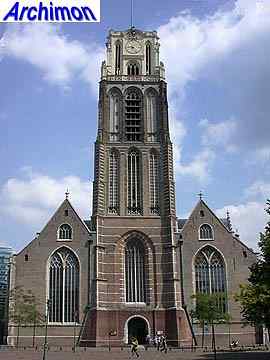
Rotterdam (ZH): Grote Kerk or St. Laurens part 1/2
 This church is known by
several names. St. Laurens and St. Laurentius both remind of its
catholic origins, while it has been also known as Grote Kerk ('great
church') since it was confiscated and became a protestant church. This church is known by
several names. St. Laurens and St. Laurentius both remind of its
catholic origins, while it has been also known as Grote Kerk ('great
church') since it was confiscated and became a protestant church.
The history of this church started when Rotterdam was still a small
town. There had been a small church before, but in the year 1409 work
started on a big church that could compete with the prestigious
churches of Delft and Dordrecht, the current cruciform basilica.
Instead of enlarging the old church the new one was built around it. By
1436 the nave was largely completed, as was most of the northern
transept-arm, and the first mass was held. The choir was built in 1448
and the following years. The tower followed in 1449 and was partly
completed in 1460. At that time it was seperated from the rest of the
church by a canal, but that problem was eventually resolved. In 1461
the canal was filled in, and the nave was lengthened. At the same time
the southern transept-arm was built. In 1488 work started on the
ambulatory. It took until the year 1547 before work on the tower
continued. By 1550 another segment had been added to it.
The church was built in a style closely related to Brabantine
Gothicism. Unusual is how the side-aisles were given their own roofs,
partly blocking the clerestorey from view and giving the church the
look of a hall-church when seen from the front. The church was built
when Gothicism had been over its height. The master-builders who
designed it and lead its construction had abandoned the verticality of
classic Gothicism.
On the 12th of November 1572 the last catholic mass was held in the
church, followed three days later by the first protestant service. The
war with Spain prevented the construction of a spire, but in 1615
Hendrick de Keyser made a design for one, which was built in 1621. In
1645 it was already removed because the wood had begun to rot. It was
replaced by another segment, this time of natural stone, in a Gothic
style that matched the rest of the tower better than the spire. The
objection that this would be too heavy was overruled. The tower however
was sagging, and proved to be dangerous for the rest of the church
during a storm in 1650. In the next five years work was carried out to
set the tower straight again and to strengthen the foundation
underneath it. For almost three centuries little more changed on the
exterior of the church. On the 14th of May 1940 German planes bombed
the centre of Rotterdam. After the debris was removed what had been a
crowded city was turned into a vast empty space, with only a few ruins
left standing. One of these ruins was that of the old St. Laurentius.
After the war functionalist architects rebuilt the centre. Despite
their objections the old church was saved from demolitions, as the only
church in the bombed part of the centre, and was completely restored
from 1952 until 1968, although the functionalists did provide a sad
environment of ugly modern buildings. Today the church is all what is
left of medieval Rotterdam. Modern skyscrapers now dominate the city's
skyline.
|

